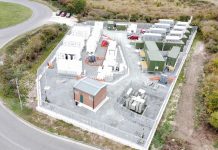 Gareth Spinner at Noveus offers an insight into the smart grid and explores some of the key issues and considerations for data centres that are looking to engage with a dynamic capacity market in the future
Gareth Spinner at Noveus offers an insight into the smart grid and explores some of the key issues and considerations for data centres that are looking to engage with a dynamic capacity market in the future
The current methodology for how capacity is provided and managed in the UK is regulated and the methodology for connections and pricing likewise. This is straightforward for existing connected customers and problematic for those who need capacity that is not readily available and comes at a very high cost. The electricity networks tend to be overstretched in pockets and on times of day rather than all the time, as much of the capacity that is contracted is not used as demand fluctuates depending on the time of day and many large consumers are not operating at full consumption.
The vision of the smart grid and smart information is that more local generation and load can be managed dynamically, to facilitate time of day demand such as charging EVs or home batteries when it best fits the grid and hence a real-time pricing methodology for energy and network charges which could better reflect cost and avoid at least in part ever increasing taxes. Network investment could also be mitigated.
How might a dynamic capacity market work?
The potential market comes from analysis of a regulated network or specific parts to discover if capacity is in short supply. Where this is the case, a number of businesses that are sitting on capacity are approached to understand what the buyout price might be to release capacity to another customer. The value customers place on capacity will vary greatly as any other commodity, based on time of day or seasonally.
With this information, customers who might need capacity are sought and where a deal can be done a tripartite arrangement is arranged. The DNO is then approached and the capacity swapped, subject to any works that may be necessary.
Smart grid Innovation

The DNOs currently see themselves very much as facilitators for ensuring electricity is provided to the customer; a conduit to get power from the generator to the customer at the point of supply. In commercial matters quite neutral. The DNO has a tried-and-tested financial model on how they will be paid for providing the network, through Use of System charges, established in 1990 when privatisation happened.
The DNOs are not likely to want to change the pricing methodology, which has delivered steady and secure income to their shareholders for 27 years, and rather than get involved in discussion on a change they are encouraging load customers, and potentially generators, to work together to agree how they might free up capacity for the benefit of growth or to allow others to connect.
Clearly the customer that has paid for their connection and capacity does not want to give that up without recompense; they can declare down on maximum demand and save on capacity charges but most know that this capacity has value. So trading capacity is being encouraged by the DNOs.
It is equally possible for a large customer to agree connections to their network and in effect release some capacity without reference to the DNO but this carries with it the risk of failure and support services on their own network and these liabilities are likely to make this scenario unpalatable.
The smart grid can facilitate this type of deal quickly and as there are no rules around what the cost of a deal would be and as a result it is exposed to the free market, it is questionable if the trading scenario is in the spirit of a publicly licenced and operated network.
The dynamic capacity market would be seeking to find the capacity commodity to trade, and therefore balance capacity and demand. Its participants could actively apply for capacity on any part of a publicly licenced network and secure capacity (at relatively low cost); then market this capacity to the highest bidder, sell part of the capacity or a site with the electricity capacity attributed.
Would the DNO or DSO treat a dynamic capacity market participant any differently to a ‘real’ customer requiring capacity? The DSO may actively support this approach if more customers were connected and the Use of System income were increased for them.
How could a smart grid facilitate a dynamic capacity market?
We could visualise the possible smart grid; information on every connected piece of equipment is accessible to determine in real time what generation is required to satisfy demand, that capacity is available on the network and this is immediately switchable and controlled. 
The ability to use smart technology to create information for a capacity market is clearly there with access to network and load information that currently is not captured or available. The smart grid roll out will not function without the requisite data collection. When in place, without data security, it would be possible to discover who has capacity in real time and seek options on capacity when it is needed, the two parties buying and selling agree and a deal is struck. The potential market could facilitate this.
So what would be needed to make this possible? The smart grid will not only have a smart meter on every point of supply but also inherently for network reasons many data points for monitoring asset condition and load. Customers forecast load requirements with time of day shape for their energy commodities could also show availability on a dedicated platform.
Regulation
Currently, the DNOs and IDNOs are each formulating their own ideas on what their smart grid or DSO would be like, seeking views from manufacturers on technology and customers on needs while maintaining a stance of being a facilitator to provide cables through which electricity can flow. They provide contracts for absolute capacity to customers, who in turn have the confidence that capacity to run their business will always be there. Without a committed capacity the business model of a data centre is not complete; the reliability and security is also fundamental to a secure DC.
The regulator is driving the DNOs for innovation to make networks more efficient (keeping losses down, fault rates down and interruptions to supply low) to avoid investment and keep bills for customers down and therefore there is a lot of discussion. So this drives a certain behaviour around technology and devices that will sense equipment condition, predict failure, estimate life expectancy and fault finding. However, is it right that this should be driven by technology companies? Is it right that the evolution is left to chance?
The regulator has a duty to ensure the licenced energy suppliers and network operators adhere to their licenced conditions and their vision of a smarter network leans to drive higher access and lower costs for customers. Where the smart grid is based on a carbon free dynamic; is it reasonable for the DSO to evolve using the same set of rules that apply to a benign electricity network?
Would customers expect the Regulator to anticipate how they are stimulating the smart grid evolution and establish new rules for the DSO? Should there be controls on access to information and data security and customer privacy?
The regulator should consider if a dynamic capacity market in the public interest and should the control of the Smart grid information be regulated to prevent abuse?
What does the DC do?
For the DC, there is an absolute need for security of data for every customer, and resilience that information is always available on demand. This requires huge levels of certainty with backup plans for the ‘what if’ moments when a disaster happens; the electricity market evolution is a long way from providing certainty.
The lack of capacity based on every consumer having an absolute amount of capacity whenever they need it is not going to be possible but if all consumers’ requirements are ‘pooled’ at local level a high degree of diversity could be possible and with smart solutions electricity could be delivered to where it is needed when it is needed.
The DC operators can, of course, take action themselves and consider different solutions. The grid connectivity carries large capacity charges but generally the grid connection is the prime source of power. Standby generation is the backup to their ever present reliable grid connection, under the DSO the inter-changeability of which source is used becomes easier and the level of available capacity could be traded.
What then for the DC that has an absolute requirement for power when it is needed? Does the DC strategy change from each site having back up supply beyond N+1 to having prime generation supply, grid charge avoidance and even duplicate data storage on disparate sites?
Would a DC consider buying capacity from a market participant, if this were cheaper than a grid connection requiring reinforcement, it is possible? Should it not be the case that the DSO should be more discerning on how capacity is actively managed with the responsibility as they have the technology to actively manage it?



